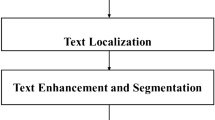Abstract
Extraction of text characters and strings from the nameplates, sign boards, printed names on bank cheques, printed postal envelope addresses and office boards can give useful information for numerous applications. The process to extract text characters from all the categories mentioned above is very complex task due to divergence in the text patterns in terms of text fonts used. Text recognition always starts with text detection. Therefore, text recognition is the process of text detection followed by text recognition. This can be done by combining image processing and machine learning together. This paper proposes a method for text detection and identification mainly on nameplates in the offices and home doors written in English language which uses Roman script. Initial step of text detection of Roman characters is carried out by using image processing and K-means clustering algorithm while later part of identification is carried out with the help of multiclass feature of support vector machine.
Access this chapter
Tax calculation will be finalised at checkout
Purchases are for personal use only
Similar content being viewed by others
References
Lu S, Li L, Tan CL (2008) Document image retrieval through word shape coding. IEEE Trans Pattern Anal Mach Intell 30(11):1913–1918
De Campos T, Babu B, Varma M (2009) Character recognition in natural images. In: Proceeding of VISAPP
Weinman JJ, Learned-Miller E, Hanson AR (2009) Scene text recognition using similarity and a lexicon with sparse belief propagation. IEEE Trans Pattern Anal Mach Intell 31(10):1733–1746
Epshtein B, Ofek E, Wexler Y (2010) Detecting text in natural scenes with stroke width transforms. In: Proceeding of CVPR, pp 2963–2970
Neumann L, Matas J (2012) Real-time scene text localization and recognition. In: Proceeding of IEEE conference on computer vision and pattern recognition, pp 3538–3545
Kulkarni SA, Borde PL, Manza RR, Yannawar PL (2015) Offline MODI character recognition using complex moments. In: Science direct, second international symposium on computer vision and the internet
Rathi SR, Jadhav RH (2015) Recognition and conversion of handwritten Modi characters. Int J Tech Res Appl 3(1):128–131
Patil PA (2016) Character recognition system for Modi script. Int J Comput Eng Res 6(9)
Chandure SL, Inamdar V (2016) Performance analysis of handwritten devanagari and MODI character recognition system. In: International conference on computing, analytics and security trends
.Gharde SS, Ramteke RJ (2016) Recognition of characters in Indian Modi script. In: International conference on global trends in signal processing, information computing and communication
Maurya RK, Maurya SR (2018) Recognition of a medieval Indic-‘Modi’ script using empirically determined heuristics in hybrid feature space. Int J Comput Sci Eng Open Access Res Pap 6(2)
Singh PK (2013) Identification of Devanagari and Roman scripts from multi-script handwritten documents. In: International conference on pattern recognition and machine intelligence, Springer, Berlin
Shelke S, Apte S (2015) A fuzzy-based classification scheme for unconstrained handwritten Devanagari character recognition. In: Communication, information & computing technology (ICCICT), 2015 international conference on IEEE
Saikat R (2017) Handwritten isolated Bangla compound character recognition: A new benchmark using a novel deep learning approach. Pattern Recogn Lett 90:15–21
Milind B (2018) Combined classifier approach for offline handwritten Devanagari character recognition using multiple features computational vision and bio-inspired computing. Springer, Cham, pp 45–54
Boufenar C (2018) An artificial immune system for offline isolated handwritten Arabic character recognition. Evolv Syst 9:25–41
Li Z (2018) Building efficient CNN architecture for offline handwritten Chinese character recognition. Preprint arXiv:1804.01259
Jagan Mohan Reddy, Vishnuvardhan Reddy DA (2019) Recognition of handwritten characters using deep convolutional neural network. IJITEE 8(6S4). ISSN: 2278-3075
Author information
Authors and Affiliations
Corresponding author
Editor information
Editors and Affiliations
Rights and permissions
Copyright information
© 2021 The Author(s), under exclusive license to Springer Nature Singapore Pte Ltd.
About this paper
Cite this paper
Dhore, M., Varpe, K. (2021). Text Recognition Using K-means Clustering and Support Vector Machine. In: Patil, V.H., Dey, N., N. Mahalle, P., Shafi Pathan, M., Kimbahune, V.V. (eds) Proceeding of First Doctoral Symposium on Natural Computing Research. Lecture Notes in Networks and Systems, vol 169. Springer, Singapore. https://doi.org/10.1007/978-981-33-4073-2_10
Download citation
DOI: https://doi.org/10.1007/978-981-33-4073-2_10
Published:
Publisher Name: Springer, Singapore
Print ISBN: 978-981-33-4072-5
Online ISBN: 978-981-33-4073-2
eBook Packages: Intelligent Technologies and RoboticsIntelligent Technologies and Robotics (R0)




